
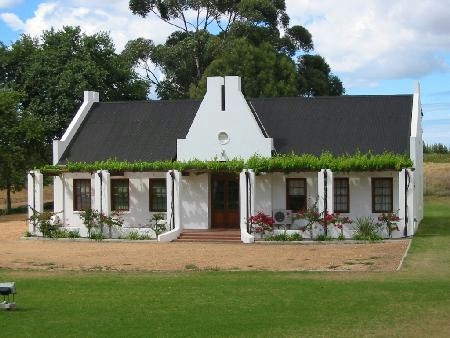

Groot Constantia
CAPE DUTCH STYLE
In the XVII century Dutch colonizers created “Cape Dutch” style: thatched sloping roof, decorated gable, plastered walls, symmetric front with triangular windows. First houses in “Cape Dutch” style had T-plan, than becoming bigger H-plan became more diffused. The use of thatched roof was abandoned after the disastrous fire of Cape Town in 1736. An example of this style is Groot Constantia, next to Cape Town, built in 1685 by the dutch governor Simon Van der Stel (October 14, 1639 – June 24, 1712, was the first Governor of the Cape of Good Hope).
 |
|
 |
|
|
Groot Constantia |
The early houses in the Cape Town area were built in the Cape Dutch Architectural style, unique to the small area of the world and unquestionably beautiful. This style has sources as widely different as mediaeval Holland and Germany, the France of the Huguenots and the islands of Indonesia.
The earliest houses were single-storied dwellings and purely utilitarian. They usually consisted of three rooms in a row and had steeply pitched roofs supported by rafters. Imported timber was used when it was obtainable but generally houses were built of local materials: walls consisted of clay or thick rubble (later of burnt brick), sea shells provided the basis for lime-mortar and wild reeds were used for thatch.
At the beginning of the 18th century, with increasing prosperity in the towns and the development of wine farms, houses began to expand. They began to reflect the growing needs and individual taste of each owner. It was at this stage that the front gable began to make its appearance. The gables, largely in the hands of skilled craftsmen imported as slaves from the east, began to develop in a variety of styles and decorations.
By the mid-18th century, homeowners
had begun to add on wings on either end of the basic structures, resulting in
the so-called U-plan. Floors were made of compacted earth or Robben Island slate
and windows were protected by shutters.
At roundabout the same time, the T-plan was evolving in the rural areas. In this
design, a single wing, with the kitchen at the end, was attached like a tail to
the center of the basic building.Later another wing was added at right angles to
the T and parallel to the original building. And so the H-plan evolved. This
plan became the ultimate design in country houses and on which some of the
western Cape's most elegant farmsteads were designed.
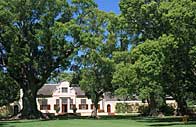 Wonderful
examples are Willem Adriaan van der Stel's Vergelegen (Somerset West), Libertas
(outside Stellenbosch) and Boschendal (Groot Drakenstein).
Wonderful
examples are Willem Adriaan van der Stel's Vergelegen (Somerset West), Libertas
(outside Stellenbosch) and Boschendal (Groot Drakenstein).
Still later, outbuildings began to appear. These included a house, or jonkershuis for the eldest son, stables and coach-house, slaves' quarters and a wine cellar. Usually a wall encircled the whole farmyard. With the backdrop of blue mountains, this presented an image of settled stability.
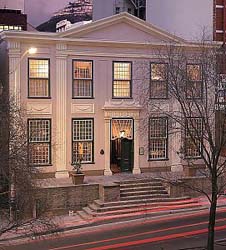 In
the towns, however, no such security existed. Open hearths were
In
the towns, however, no such security existed. Open hearths were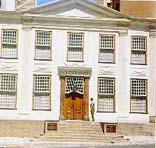 in
every kitchen and houses were built close to each
other. When the notorious southeast
wind blew, town houses were prey to fires wiping out entire streets at a time.
By the end
of the 18th century many of Cape Town's thatched and gabled dwellings
had vanished. Houses appeared in a new guise - flat-roofed and pediment and
often double-storied. Of the few that remain today, the Koopmans-De Wet House in
Strand Street (Cape Town) is the most famous and beautiful example.
in
every kitchen and houses were built close to each
other. When the notorious southeast
wind blew, town houses were prey to fires wiping out entire streets at a time.
By the end
of the 18th century many of Cape Town's thatched and gabled dwellings
had vanished. Houses appeared in a new guise - flat-roofed and pediment and
often double-storied. Of the few that remain today, the Koopmans-De Wet House in
Strand Street (Cape Town) is the most famous and beautiful example.
The early Cape houses were built very symmetrically. On the facade, the central front door was the builder's focal point and two half-windows with two or four full-width windows almost always flanked this equally spaced along either side.
Most house cases had a front room (voorkamer) into which the entrance led. This gave access to the rooms on either side and led to the back room (agterkamer)
The kitchens had open fireplaces and a Dutch oven
fitted with iron bars to hold cooking pots. In Cape Town chimneys were being
ruled out because of the threat of fire. In rural areas, the floors were often
made of compacted peach pips and ceilings consisted of reeds or saplings.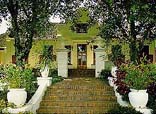
 Some
of the
finest examples of Cape Dutch houses were built in the
early 19th century.La Provence (Franschhoek),
Old Nectar (Stellenbosch) and Nederburg
(Paarl) were completed. Towards the middle of the
nineteenth century, they began being superseded by other architectural styles.
Some
of the
finest examples of Cape Dutch houses were built in the
early 19th century.La Provence (Franschhoek),
Old Nectar (Stellenbosch) and Nederburg
(Paarl) were completed. Towards the middle of the
nineteenth century, they began being superseded by other architectural styles.
http://www.encounter.co.za/article/19.html